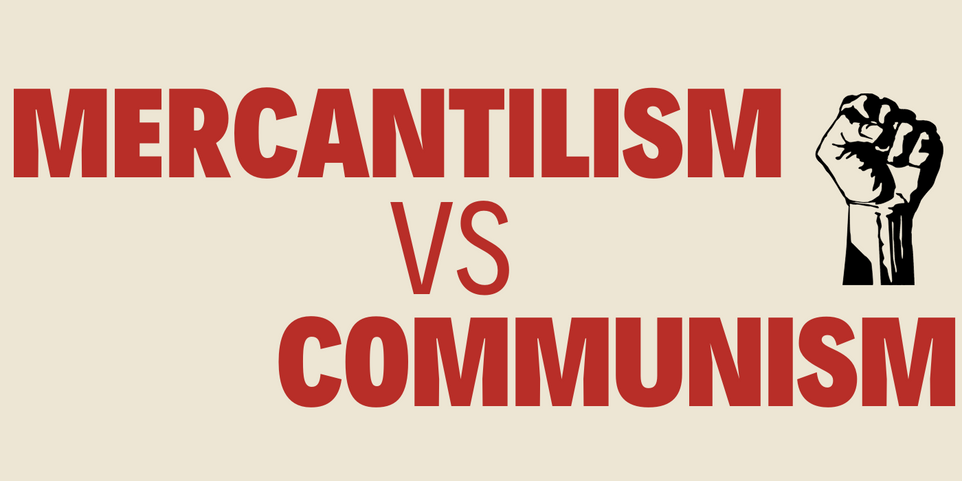Two prominent economic ideologies that have shaped history and influenced nations’ policies are mercantilism and communism.
Each system represents distinct approaches to organizing economies, with its unique set of principles, objectives, and impacts.
Overview of mercantilism and communism
Mercantilism
Mercantilism emerged during the early modern period (16th to 18th centuries) as a dominant economic theory in Europe.
Its central focus was on accumulating wealth and increasing a nation’s power through trade and a favorable balance of trade.
Mercantilist policies encouraged exports and discouraged imports to accumulate gold and silver, which were believed to be the basis of a nation’s wealth.
Communism
Communism, on the other hand, is a socio-economic ideology that advocates for collective ownership of resources and the means of production.
It seeks to establish a classless society where wealth and resources are shared equitably among all members.
The goal of communism is to eliminate social and economic disparities, aiming for a stateless and classless society.
Explore Mercantilism in detail
Definition and historical context
Mercantilism can be defined as an economic theory and practice that prevailed in Europe during the early modern period, roughly from the 16th to the 18th centuries.
It was characterized by a focus on increasing a nation’s wealth and power through trade and a positive balance of trade. The period of mercantilism coincided with the growth of European colonialism, and nations sought to expand their empires and secure valuable resources from their colonies.

Core principles and objectives
1. Accumulation of wealth
The primary objective of mercantilism was to accumulate wealth, particularly in the form of precious metals like gold and silver. Nations believed that amassing these metals would increase their economic and military power.
2. Favorable balance of trade
Mercantilists emphasized exporting more goods than importing, aiming to achieve a trade surplus. This was achieved by imposing tariffs and other trade barriers on imports while supporting domestic industries to boost exports.
3. Colonization and resource acquisition
European powers engaged in colonization to secure access to valuable resources in their colonies, further enhancing their economic strength.
Key features and characteristics
· Protectionism
Mercantilist policies relied heavily on protectionism, using tariffs and trade restrictions to protect domestic industries from foreign competition and promote self-sufficiency.
· State intervention
Governments played a central role in regulating economic activities, with strong control over trade, industry, and commerce.
· Bullionism
Bullionism was the belief that accumulating precious metals like gold and silver was crucial for a nation’s economic prosperity.

Advantages and benefits of Mercantilism
Mercantilism, in its early stages, contributed to the growth of domestic industries and economies, as governments supported local production.
Moreover, pursuit of mercantilist policies often led to the expansion of colonial empires, giving nations access to new resources and markets.
Criticisms and limitations
Trade wars: Mercantilist policies could spark trade conflicts and wars between nations as they vied for economic supremacy.
Neglect of individual welfare: Critics argue that mercantilism prioritized the interests of the state over the well-being of individuals and consumers.
Misunderstanding of wealth: The emphasis on precious metals as a measure of wealth neglected the broader concept of economic development and well-being.
Despite its historical significance, mercantilism gradually gave way to other economic theories like capitalism, which emerged during the Industrial Revolution. However, some aspects of mercantilist thinking still influence modern economic policies.
Explore Communism in detail
Definition and historical context
Communism is a socio-economic and political ideology that originated as a response to the social inequalities and exploitative practices prevalent during the industrialization period.
The roots of communism can be traced back to the works of Karl Marx and Friedrich Engels, who outlined their ideas in the seminal work, “The Communist Manifesto,” published in 1848.
Communism aimed to create a classless and stateless society, where wealth and resources were collectively owned and shared among all members.
Core principles and objectives
1. Collective ownership
Communism advocates for the abolition of private property and the establishment of collective ownership of resources, means of production, and wealth.
2. Classless society
The central goal of communism is to eliminate social classes, eradicating the distinction between the bourgeoisie (capitalist class) and the proletariat (working class).
3. Planned economy
In a communist system, economic decisions are made centrally by the state, with a planned economy aiming to allocate resources and goods based on societal needs rather than market forces.
Key features and characteristics
· Abolition of private property
Under communism, private ownership of means of production and resources is replaced with collective ownership to eliminate exploitation.
· Central planning
The state plays a pivotal role in planning and managing the economy, deciding what to produce and how to distribute goods and services.
· Equality and social justice
Communism seeks to create a society where all individuals have equal access to resources, education, healthcare, and opportunities.
Advantages and benefits of communism

Elimination of social inequality: Communism addresses wealth disparities by striving for a more equitable distribution of resources, aiming to uplift the entire society.
Focus on social welfare: In a communist system, the welfare of the community is prioritized over individual interests.
Shared prosperity: The goal of communism is to ensure that the benefits of economic growth and development are enjoyed collectively by all members of society.
Criticisms and limitations
Lack of incentives: Critics argue that communism’s collective ownership might undermine individual motivation and innovation, potentially leading to a less dynamic economy.
Centralized control: The concentration of power in a communist state could lead to inefficiencies and bureaucratic challenges.
Critics point to historical cases where communist regimes resulted in authoritarian governments and human rights abuses.
Although the ideology of communism has been influential and has inspired social and political movements worldwide, practical implementations have been complex and faced various challenges.
Comparison between Mercantilism vs Communism
| Comparison between Mercantilism vs Communism | |
| A. Economic philosophy and ideology | |
| Mercantilism: | Communism: |
| Mercantilism is primarily an economic doctrine focused on promoting a nation’s economic power and wealth through trade and protectionist policies. It emphasizes accumulating precious metals, fostering domestic industries, and pursuing favorable trade balances. | Communism, on the other hand, is a comprehensive socio-economic and political ideology that seeks to create a classless and stateless society. It advocates for the abolition of private property and the collective ownership of resources and means of production, aiming to eliminate social classes and establish equality. |
| B. Role of the government | |
| Mercantilism: | Communism: |
| In mercantilist economies, governments play an active role in regulating and controlling economic activities. They implement protectionist measures, subsidies, and incentives to promote domestic industries and trade. | Communism envisions a centrally planned economy where the state assumes significant control over resource allocation, production, and distribution. The government’s role is crucial in ensuring equitable access to resources and eliminating economic disparities. |
| C. Trade and international relations | |
| Mercantilism: | Communism: |
| Mercantilist policies emphasize export-led growth and securing favorable trade balances. Nations often engage in economic rivalries and protectionist measures to gain a competitive advantage in global trade. | Communism aims to transcend national boundaries and foster international solidarity among the working class. In practice, communist states have often focused on strengthening ties with other communist nations, but tensions with capitalist countries have also arisen. |
| D. Income distribution and ownership of resources | |
| Mercantilism: | Communism: |
| Mercantilism does not specifically address income distribution, and its focus on accumulating wealth can result in income disparities. Private ownership of resources and means of production remains prevalent. | In communist systems, resources are collectively owned, and income distribution is meant to be equitable. The goal is to eliminate wealth disparities between different social classes. |
| E. Economic efficiency and innovation | |
| Mercantilism: | Communism: |
| Mercantilism’s protectionist measures can hinder economic efficiency and innovation, as domestic industries may become complacent without facing international competition. | Critics argue that communism’s centralized planning may stifle entrepreneurial spirit and innovation, leading to inefficiencies and limited economic growth. |
It is essential to recognize that both mercantilism and communism emerged in different historical contexts and reflect diverse perspectives on how economies should be structured. While mercantilism has largely been replaced by capitalist systems, and communism has faced numerous challenges in practice, both ideologies have contributed to shaping economic thought and continue to be subjects of academic and political debate.
Case Studies
Historical examples of countries practicing mercantilism
Spain during the Age of Exploration
In the 16th century, Spain embraced mercantilist policies to expand its wealth and power through colonization and trade. The acquisition of precious metals, especially gold and silver, from its American colonies was a central focus, leading to the growth of Spain’s economy and influence.
England during the British Mercantilist Era
In the 17th and 18th centuries, England pursued mercantilism to bolster its economic strength. The Navigation Acts, for instance, restricted colonial trade to English ships and ensured that most of the colonial goods were sold in England, helping to build a powerful navy and support domestic industries.
Historical examples of countries implementing communism
Soviet Union
One of the most significant examples of a communist state was the Soviet Union. After the 1917 Bolshevik Revolution, the Soviet government led by Vladimir Lenin implemented communist principles, nationalizing industry, and collectivizing agriculture. The state played a dominant role in economic planning and resource allocation.
China
Following the Chinese Communist Revolution in 1949, China adopted communist policies under the leadership of Mao Zedong. The government implemented land reforms and nationalized industries to create a socialist economy, with significant state control over production and distribution.
Analysis of their economic outcomes and impacts
While mercantilism contributed to the growth of economies and strengthened colonial powers during its time, its emphasis on protectionism and accumulation of precious metals has been criticized for limiting international trade and economic progress in the long run.
The implementations of communism varied across different countries and time periods. In some cases, like the Soviet Union, it led to rapid industrialization and improvements in education and healthcare. However, in many instances, centralized planning and lack of incentives hindered economic efficiency and innovation, leading to economic stagnation and shortages of essential goods.
Modern Applications and Relevance
How mercantilist ideas still influence economic policies today
Some countries continue to employ protectionist measures, such as tariffs and trade restrictions, to safeguard domestic industries and maintain favorable trade balances.
Nations often prioritize their economic interests when engaging in international trade negotiations and forming trade agreements.
Governments may implement policies to support specific industries deemed strategically important for national economic growth and security.
The role of communism in modern political and economic discourse
Communism remains a subject of ideological debates, with some advocating for its principles as a solution to economic inequality and exploitation.
While not fully communist, several countries have implemented socialist policies aimed at reducing income disparities and providing social welfare benefits to citizens.
Despite the decline of state-led communism, communist and socialist ideologies continue to shape political movements and policies in various parts of the world.
Final thoughts
The comparison between mercantilism and communism highlights the evolution of economic ideologies over time.
As we navigate the ever-changing landscape of business and finance, understanding the historical context and principles of different economic ideologies helps us shape more informed and adaptive policies for the benefit of society as a whole.

